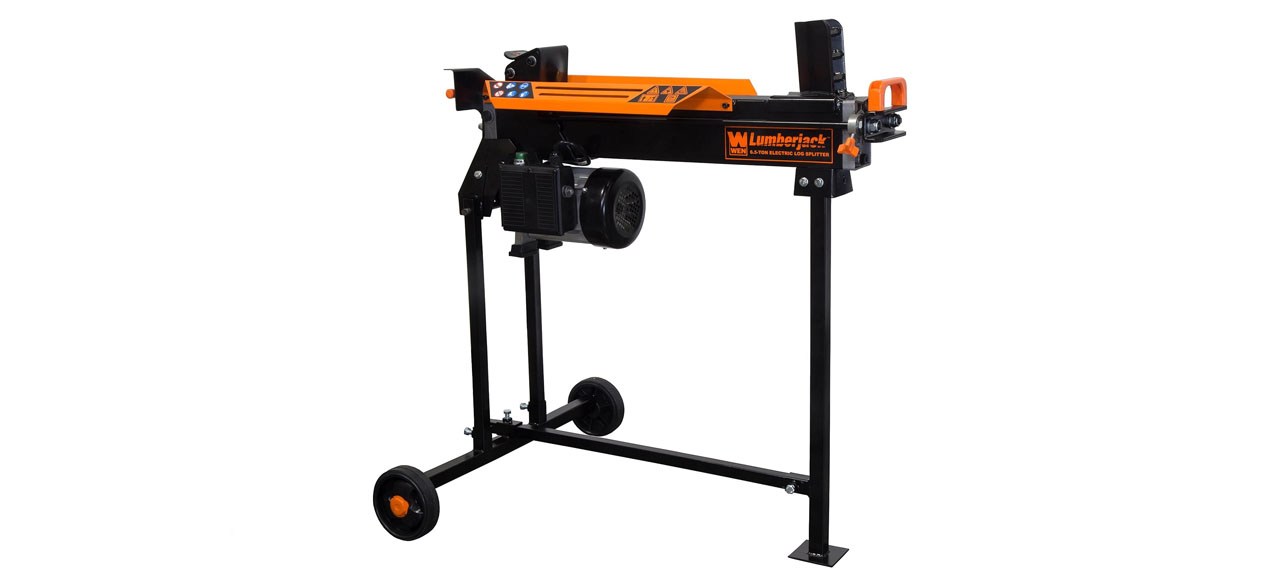Which log splitters are best?
Unless you consider splitting logs to be part of your fitness routine, you probably want to avoid the backbreaking work of doing it with an ax, not to mention the obvious dangers involved with that method. A log splitter allows you to avoid both of these issues. They’re available in manual, electric and gas options.
For the majority of consumers who don’t need to split excessively large logs or run through an extremely high volume of cords, an electric model like the WEN 6.5-Ton Electric Log Splitter will do the job. It’s reasonably priced, requires almost no maintenance and can handle logs up to 10 inches in diameter and 20.5 inches in length.
What to know before you buy a log splitter
Safety
Log splitters are very useful pieces of equipment, but they can be dangerous if you don’t follow proper safety precautions. Before using your machine for the first time, read through the entire instruction manual to ensure you have a thorough understanding of how it works and what to do. It’s important to only operate your log splitter when you’re alert and well-rested.
Never put your hands anywhere near the splitting area when a log splitter is in action. Make sure to wear safety glasses the entire time to protect your eyes from small pieces of wood that may go flying. You should also wear gloves to protect your hands from splinters and sturdy footwear. If using a gas-powered model, it’s a good idea to wear hearing protection.
Power source
Log splitters may be manual, electric or gas-powered. Manual models may be as simple as metal guides that are combined with a sledgehammer to drive a wedge into a log, or they may use hydraulics. The latter are more expensive but require significantly less effort on your part.
Electric log splitters are popular because they’re quiet, emission-free and require almost no maintenance. They tend to be smaller and easier to move than gas-powered models. However, they aren’t as powerful, so they may not be suitable for someone who regularly splits a lot of large logs.
Gas-powered splitters are the most capable, but they’re also the loudest and dirtiest. They require more maintenance than the other types as well. That said, they’re a good choice for those who need to split logs in places where they won’t have access to power or who need to split very large logs.
Splitting orientation
Log splitters may cut logs in a vertical or horizontal orientation. Neither type is inherently better than the other; however, some people may find it easier to load large and heavy logs in vertical splitters since you don’t have to lift them as high off the ground.
What to look for in a quality log splitter
Driving force
Every log splitter has a maximum driving force that determines what kind of logs it can handle. The higher the driving force, the better a splitter is able to handle hardwood varieties. It also increases its ability to handle very long or thick logs. Most manual and electric log splitters have a driving force from 4,000-10,000 pounds, while gas log splitters may have as many as 20,000 pounds. For the majority of people, a splitter with 6,000-10,000 pounds of driving force should meet their needs.
Log capacity
Along with the driving force, pay close attention to the log capacity. This is determined by a combination of the driving force, ram size and cradle size. For consumer-level electric and manual models, it’s common to accommodate logs with a maximum diameter of 8-12 inches and a maximum length of 16-20 inches. If you expect to cut logs bigger than that, you’ll likely need to purchase a gas log splitter.
Cycle time
The cycle time refers to the amount of time it takes for the ram to split a log and return to the starting position. The shorter the cycle time, the faster you can work through large piles of logs. Cycle times can range anywhere from six to 25 seconds.
Automatic ram return
On some log splitters, you need to manually return the ram to the starting position. Models with an automatic ram return function eliminate this step for more convenient operation.
Wheels
Log splitters are generally heavy pieces of equipment. Models equipped with wheels are easier to position as needed. The larger the wheels, the better you’re able to maneuver a log splitter over uneven ground.
How much you can expect to spend on a log splitter
Manual log splitters cost $50-$200. Electric splitters cost $250-$500. Gas log splitters can cost anywhere from $300-$1,500 or more.
Log splitter FAQ
Do log splitters require any maintenance?
A. The amount of maintenance log splitters require varies by type. With manual and electric models, you may need to periodically add some hydraulic fluid, but that’s pretty much it. With gas log splitters, you’ll need to monitor oil levels, periodically clean filters, check the spark plugs and perform all the other maintenance that gas engines typically require.
Is it better to split fresh or dry logs?
A. Cut logs dry quicker than whole logs. Because of this, many people choose to split their logs when they’re still fresh so they don’t have to wait so long to use them as firewood. That said, fresh logs require more driving force, so you’ll need to make sure you purchase a machine with enough power for that.
What’s the best log splitter to buy?
Top log splitter
WEN 6.5-Ton Electric Log Splitter
What you need to know: The WEN log splitter is the perfect choice for many users because it offers an ideal balance of power, capacity, and portability.
What you’ll love: It can handle logs up 10 inches in diameter and 20.5 inches in length, which is more than most splitters of its size. Plus, it comes with a tall, optional-use 34-inch stand so you don’t have to hunch over to operate it.
What you should consider: It’s difficult to lift the splitter onto the stand without a second person’s help.
Top log splitter for the money
Sun Joe LJ10M 10-Ton Hydraulic Log Splitter
What you need to know: If you need a lot of driving force but don’t want to deal with a noisy and messy gas-powered machine, the manual hydraulic LJ10M is the way to go.
What you’ll love: It’s equipped with springs for automatic ram return, which saves time and makes your job easier. It also features long handles for comfortable operation.
What you should consider: It requires a good amount of physical effort, so it wouldn’t be the right choice for anyone who needs to split a lot of cords of wood.
Worth checking out
What you need to know: This powerful log splitter can power through making trees into firewood.
What you’ll love: This log splitter has a lot of features to make it easy to cut and haul logs around your property. It has a splitting force of 20 tons and supports to stabilize the logs. It also has wheels and a handle so you can move it around easily.
What you should consider: It’s significantly more expensive than the other picks. Some people also had issues with oil leaks.
Prices listed reflect time and date of publication and are subject to change.
Check out our Daily Deals for the best products at the best prices and sign up here to receive the BestReviews weekly newsletter full of shopping inspo and sales.
BestReviews spends thousands of hours researching, analyzing and testing products to recommend the best picks for most consumers. BestReviews and its newspaper partners may earn a commission if you purchase a product through one of our links.












